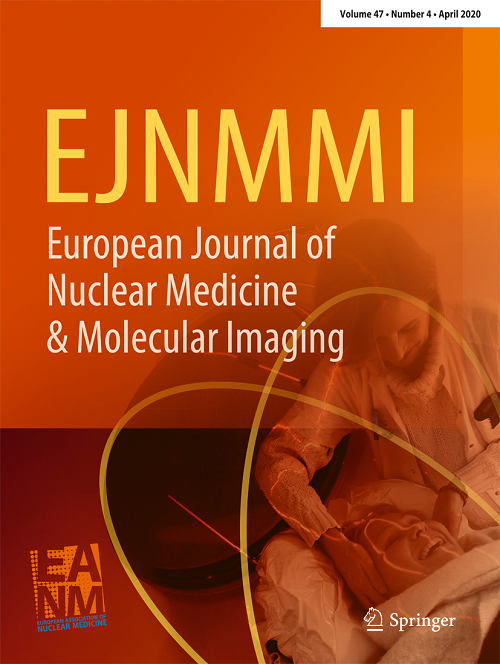Spatial imaging features derived from SUVmax location in resectable NSCLC are associated with tumor aggressiveness.
IF 7.6
1区 医学
Q1 RADIOLOGY, NUCLEAR MEDICINE & MEDICAL IMAGING
European Journal of Nuclear Medicine and Molecular Imaging
Pub Date : 2025-08-21
DOI:10.1007/s00259-025-07528-0
引用次数: 0
Abstract
PURPOSE Accurate non-invasive prediction of histopathologic invasiveness and recurrence risk remains a clinical challenge in resectable non-small cell lung cancer (NSCLC). We developed and validated the Edge Proximity Score (EPS), a novel [18F]FDG PET/CT-based spatial imaging feature that quantifies the displacement of SUVmax relative to the tumor centroid and perimeter, to assess tumor aggressiveness and predict progression-free survival (PFS). METHODS This retrospective study included 244 NSCLC patients with preoperative [18F]FDG PET/CT. EPS was computed from normalized SUVmax-to-centroid and SUVmax-to-perimeter distances. A total of 115 PET radiomics features were extracted and standardized. Eight machine learning models (80:20 split) were trained to predict lymphovascular invasion (LVI), visceral pleural invasion (VPI), and spread through air spaces (STAS), with feature importance assessed using SHAP. Prognostic analysis was conducted using multivariable Cox regression. A survival prediction model incorporating EPS was externally validated in the TCIA cohort. RNA sequencing data from 76 TCIA patients were used for transcriptomic and immune profiling. RESULTS EPS was significantly elevated in tumors with LVI, VPI, and STAS (P < 0.001), consistently ranked among the top SHAP features, and was an independent predictor of PFS (HR = 2.667, P = 0.015). The EPS-based nomogram achieved AUCs of 0.67, 0.70, and 0.68 for predicting 1-, 3-, and 5-year PFS in the TCIA validation cohort. High EPS was associated with proliferative and metabolic gene signatures, whereas low EPS was linked to immune activation and neutrophil infiltration. CONCLUSION EPS is a biologically relevant, non-invasive imaging biomarker that may improve risk stratification in NSCLC.可切除的非小细胞肺癌中SUVmax位置的空间成像特征与肿瘤侵袭性相关。
目的:在可切除的非小细胞肺癌(NSCLC)中,对组织病理学侵袭性和复发风险进行准确的无创预测仍然是一个临床挑战。我们开发并验证了边缘接近评分(Edge Proximity Score, EPS),这是一种新颖的[18F]FDG PET/ ct为基础的空间成像特征,量化了SUVmax相对于肿瘤质心和周长的位移,以评估肿瘤的侵袭性并预测无进展生存期(PFS)。方法回顾性研究244例NSCLC患者术前FDG PET/CT检查[18F]。EPS由归一化suvmax到质心和suvmax到周长的距离计算。提取并标准化了115个PET放射组学特征。8个机器学习模型(80:20分割)被训练来预测淋巴血管侵犯(LVI)、内脏胸膜侵犯(VPI)和通过空气空间扩散(STAS),并使用SHAP评估特征重要性。采用多变量Cox回归进行预后分析。纳入EPS的生存预测模型在TCIA队列中进行了外部验证。76例TCIA患者的RNA测序数据用于转录组学和免疫分析。结果LVI、VPI和STAS肿瘤的tsps显著升高(P < 0.001),稳居SHAP的前三位,是PFS的独立预测因子(HR = 2.667, P = 0.015)。在TCIA验证队列中,基于eps的nomogram预测1、3和5年PFS的auc分别为0.67、0.70和0.68。高EPS与增殖和代谢基因特征有关,而低EPS与免疫激活和中性粒细胞浸润有关。结论eps是一种具有生物学相关性的无创成像生物标志物,可改善非小细胞肺癌的风险分层。
本文章由计算机程序翻译,如有差异,请以英文原文为准。
求助全文
约1分钟内获得全文
求助全文
来源期刊
CiteScore
15.60
自引率
9.90%
发文量
392
审稿时长
3 months
期刊介绍:
The European Journal of Nuclear Medicine and Molecular Imaging serves as a platform for the exchange of clinical and scientific information within nuclear medicine and related professions. It welcomes international submissions from professionals involved in the functional, metabolic, and molecular investigation of diseases. The journal's coverage spans physics, dosimetry, radiation biology, radiochemistry, and pharmacy, providing high-quality peer review by experts in the field. Known for highly cited and downloaded articles, it ensures global visibility for research work and is part of the EJNMMI journal family.

 求助内容:
求助内容: 应助结果提醒方式:
应助结果提醒方式:


